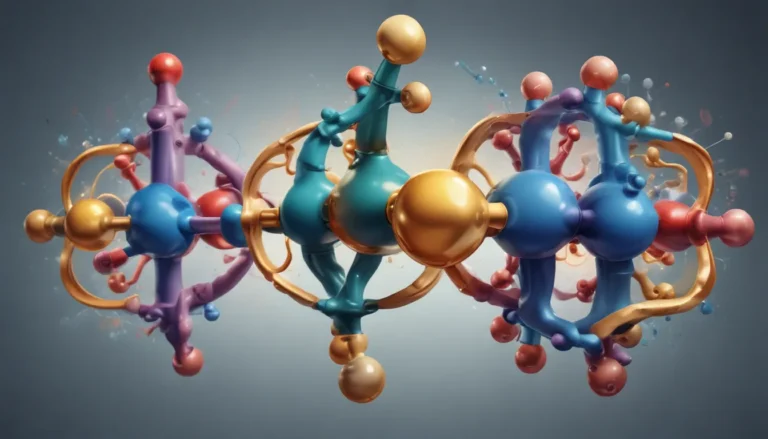A Note About Images: The images used in our articles are for illustration purposes only and may not exactly match the content. They are meant to engage readers, but the text should be relied upon for accurate information.
Welcome to the captivating world of steric number, a fundamental concept in organic chemistry that holds the key to understanding the spatial arrangement of atoms in molecules. Delving into the realm of steric number can unveil a treasure trove of insights into molecular geometry, reactivity, and stability. Join us on this enlightening journey as we explore 15 mind-blowing facts that will enrich your knowledge and deepen your appreciation for this essential principle in chemistry.
Unraveling the Mysteries of Steric Number
Steric number serves as a molecular puzzle piece, dictating the shape and stability of molecules while influencing their reactivity and polarity. By grasping the concept of steric number, chemists gain a valuable tool for predicting molecular geometry, bond angles, and even drug effectiveness. It’s like having a secret code that unlocks the mysteries of chemical structures and reactions, paving the way for groundbreaking discoveries and innovations in the field of chemistry.
The Key Role of Steric Number in Molecular Geometry
At the core of steric number lies its crucial role in determining the three-dimensional shape of molecules. By identifying the arrangement of atoms and lone pairs around a central atom, steric number provides essential insights into the geometry of molecules, laying the foundation for a deeper understanding of their properties and behavior.
Calculating Steric Number: A Simple Formula
To calculate the steric number of a molecule, simply add the number of atoms bonded to the central atom with the number of lone pairs present on the central atom. This straightforward formula provides a quick and effective way to determine the steric number and unravel the molecular puzzle piece that governs the molecule’s shape and structure.
Steric Number and Hybridization: A Close Relationship
The steric number not only reveals the molecular geometry but also sheds light on the hybridization state of the central atom. By providing valuable information about whether the central atom undergoes sp, sp2, sp3 hybridization, or other forms of hybridization, steric number serves as a key determinant of the molecular architecture and bonding in a molecule.
Impact on Bond Angles and Molecular Properties
The steric number exerts a significant influence on the bond angles within a molecule, shaping its overall geometry and properties. By affecting the molecular shape, steric number plays a pivotal role in determining the molecule’s reactivity, polarity, and stability, offering a comprehensive view of its chemical behavior.
Predicting Molecular Polarity with Steric Number
By analyzing the steric number, chemists can make informed predictions about the polarity of a molecule. Variations in steric number can result in distinct polarities, impacting the molecule’s intermolecular interactions, solubilities, and overall chemical properties. Understanding the relationship between steric number and polarity enhances our ability to decipher the intricate nature of molecular structures.
Steric Number in Organic and Inorganic Chemistry
The concept of steric number transcends the boundaries of organic and inorganic chemistry, serving as a cornerstone for understanding the structure, properties, and behavior of a diverse range of compounds. Whether exploring the intricacies of organic molecules or the complexities of inorganic substances, steric number provides a universal language that decodes the fundamental principles of chemistry.
Unveiling the Stability Factors: Steric Number’s Impact
Molecules with higher steric numbers often exhibit reduced stability due to increased repulsion between atoms or lone pairs. The phenomenon of steric hindrance, caused by bulky substituents, can compromise the overall stability of a molecule, highlighting the delicate balance between molecular structure and stability.
Decoding the VSEPR Theory with Steric Number
Steric number serves as a foundational concept for the Valence Shell Electron Pair Repulsion (VSEPR) theory, which elucidates the geometric arrangement of atoms in molecules based on the repulsion between electron pairs. By leveraging the insights provided by steric number, chemists can unravel the mysteries of molecular geometry and bond angles, offering a comprehensive understanding of chemical bonding.
Implications for Chemical Reactions: Steric Effects
In reactions involving molecules with high steric numbers, the presence of bulky substituents can lead to steric hindrance, hindering the approach of other molecules or reactants. This can impede reaction rates, alter reaction pathways, or even inhibit certain chemical processes, underscoring the critical role of steric effects in chemical reactivity.
Influence on Transition State Stability
The steric number plays a pivotal role in determining the stability of transition state intermediates, which are transient species formed during chemical reactions. Higher steric numbers can elevate the energy barriers associated with these processes, impacting the kinetics and outcomes of chemical transformations, and offering valuable insights into the dynamics of chemical reactions.
Steric Effects on Organic Reactivity
Steric number exerts a profound influence on the reactivity of organic compounds, shaping the accessibility of functional groups and pathways within a molecule. Bulky substituents can hinder or favor specific reactions, influencing the ease and selectivity of chemical transformations, and highlighting the intricate interplay between molecular structure and organic reactivity.
Unveiling the World of Steric Chemistry
The term “sterics” encompasses the study of spatial arrangement, molecular geometry, and the effects of these factors on chemical properties and reactivity. Steric number serves as a cornerstone within the field of sterics, offering a fundamental framework for exploring the intricacies of molecular structures and interactions, and paving the way for groundbreaking discoveries in chemistry.
Diverse Isomers Arising from Varied Steric Numbers
Different steric numbers can give rise to diverse isomers, compounds with the same molecular formula but distinct structural arrangements. Each isomer exhibits unique properties and characteristics, underscoring the profound impact of steric number on the structural diversity and complexity of chemical compounds.
Impact on Molecular Collisions and Chemical Reactions
In chemical reactions, the steric number can influence the frequency and orientation of molecular collisions, altering reaction rates and outcomes. Bulky substituents may promote or hinder collisions, affecting the dynamics of chemical transformations and offering valuable insights into the factors that govern reaction kinetics.
Harnessing Steric Number in Drug Discovery
The significance of steric number extends to the realm of drug discovery and design, where understanding the geometric and steric properties of molecules is essential for optimizing drug compounds. By leveraging the insights provided by steric number, scientists can tailor drug molecules for enhanced efficacy, reduced side effects, and improved therapeutic outcomes, underscoring the pivotal role of steric considerations in pharmaceutical research.
Conclusion: Unlocking the Secrets of Steric Number
In conclusion, steric number emerges as a cornerstone concept in the realm of molecular geometry and chemical reactivity. By unraveling the mysteries of steric number, chemists can unlock a world of insights into molecular shape, bond angles, and hybridization, offering a comprehensive understanding of the properties and behaviors of diverse compounds. Through exploring the fascinating facets of steric number, we gain a deeper appreciation for its significance in chemistry and its invaluable contributions to scientific discovery and innovation.
FAQs: Your Guide to Steric Number
Q: What is steric number?
A: Steric number is the total number of atoms bonded to a central atom plus the number of lone pairs of electrons on that atom.
Q: How is steric number determined?
A: Steric number can be determined by counting the number of atoms bonded to the central atom and adding the number of lone pairs present.
Q: What is the significance of steric number?
A: Steric number determines the molecular shape, bond angles, and hybridization of a molecule, which in turn affects its properties and reactivity.
Q: What is the relationship between steric number and hybridization?
A: The steric number determines the type of hybrid orbitals formed by the central atom, which influences the molecular geometry and bond angles.
Q: How does steric hindrance affect chemical reactions?
A: Steric hindrance caused by bulky groups in a molecule can restrict the approach of other molecules or reagents, affecting the rate and outcome of chemical reactions.
Q: Can steric number be zero?
A: No, steric number cannot be zero as there must be at least one bonded atom or lone pair present on the central atom.
Q: How does steric number differ from coordination number?
A: Steric number is specific to the central atom in a molecule and includes both bonded atoms and lone pairs, whereas coordination number refers to the number of atoms directly bonded to a central metal atom in a complex.
Q: Are all molecules with the same steric number identical in shape?
A: No, molecules with the same steric number can have different shapes depending on factors such as the presence of lone pairs, electronegativity, and molecular symmetry.
Q: Is steric number applicable to all types of molecules?
A: Yes, steric number is applicable to all types of molecules, including organic and inorganic compounds, as long as there is a central atom with bonded atoms and/or lone pairs.
Q: Can steric number change during a chemical reaction?
A: Yes, steric number can change during a chemical reaction if the geometry around the central atom is altered due to bond formation/breaking or the addition/removal of lone pairs.
Elevate Your Understanding of Chemistry with Steric Number
Embark on a journey through the intricate world of chemistry by exploring the profound implications of steric number on molecular structure, reactivity, and stability. Uncover the hidden dimensions of molecular geometry, bond angles, and hybridization, guided by the illuminating insights provided by steric number. Embrace the transformative power of chemistry as you delve into the fascinating realm of steric effects and molecular interactions, unlocking new avenues for scientific exploration and discovery. Join us in unraveling the wonders of steric number and expanding your horizons in the captivating field of chemistry.






